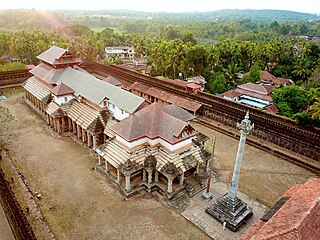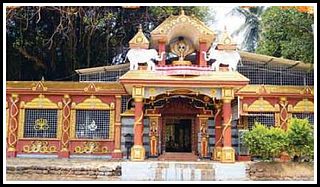
Udupi is a city in the Indian state of Karnataka. Udupi is situated about 55 km (34 mi) north of the educational, commercial and industrial hub of Mangalore and about 422 km (262 mi) west of state capital Bangalore by road.

Tulunad or Tulu Nadu, also called Bermere sristi or Parashurama Srishti, is a region and a proposed state on the southwestern coast of India. The Tulu people, known as 'Tuluva', speakers of Tulu, a Dravidian language, are the preponderant ethnic group of this region. South Canara, an erstwhile district and a historical area, encompassing the undivided territory of the contemporary Dakshina Kannada and Udupi districts of Karnataka State and Kasaragod district of Kerala state forms the cultural area of the Tuluver.

Belle is a village in the southern state of Karnataka, India. It is located in the Udupi taluk of Udupi district. The village is known for its historic Moodu-Belle Mahalingeshwara Temple dedicated to Shiva.
The Tulu people or Tuluvas are an ethno-linguistic group from Southern India. They are native speakers of the Tulu language and the region they traditionally inhabit is known as Tulu Nadu. This region comprises the districts of Dakshina Kannada and Udupi in Karnataka and a part of Kasaragod district in Kerala, with Mangalore, Karnataka being the commercial hub. The Census report of 2011 reported a population of 1,846,427 native Tulu speakers living in India.

Naga Panchami is a day of traditional worship of Nag or snakes observed by Hindus, Jains, and Buddhists throughout India, Nepal, and other countries where Hindu, Jain, and Buddhist adherents live. The worship is offered on the fifth day of bright half of lunar month of Shravana (July/August), according to the Hindu calendar. Some Indian states, such as Karnataka, Rajasthan and Gujarat, celebrate Naga Panchami on the dark half of the same month. As part of the festivities, a Naga or serpent deity made of silver, stone, wood, or a painting of snakes is given a reverential bath with milk and their blessings are sought for the welfare of the family. Live snakes, especially cobras, are also worshipped on this day, especially with offerings of milk and generally with the assistance of a snake charmer.
The Shivalli Brahmins are a Hindu community in Karnataka. They are divided into two groups, the first of which follows the Dvaita philosophy founded by the Vaishnava saint Madhvacharya of Udupi are called Shivalli Madhva Brahmins, and the second of which follow the Advaita philosophy of Adi Shankara and are known as Shivalli Smartha Brahmins. Majority of Shivalli Brahmins are Madhvas and only a few of them are Smarthas.

Nagaradhane is a form of serpent worship which, along with Bhuta Kola, is one of the unique traditions prevalent in coastal districts of Dakshina Kannada, Udupi and Kasaragod collectively known as Tulu Nadu, practiced by Tuluva community members. Cobras are not just seen as deities, but as an animal species which should be respected, appeased and protected for multiple social, religious and ecological reasons.

Pili Vesha in "Tiger Masque" is a folk dance unique in coastal Karnataka. Pilivēṣa is performed during Navratri to honour the Goddess Durga whose favoured animal is the tiger. Which is called mārnemi. Mangalore Dasara is one of the festivals during which large number of enthusiasts participate in this ritual. It was originated in Udupi District of Karnataka and initially performed during the Krishna Janmashtami/Mosarukudike and Ganesha Chaturthi at Mangalore, Udupi, Moodabidri, Kundapur and many other places in Tulu Nadu.

Kukke Subramanya is a Hindu temple located in the village Subramanya, of Kadaba taluk in Dakshina Kannada district, Karnataka, India. In this temple Kartikeya is worshipped as Subramanya, lord of all serpents. The epics relate that the divine serpent Vasuki and other serpents found refuge under Subramanya when threatened by the Garuda. The priests in the temple are Shivalli Madhva Brahmins. The poojas and other daily rituals in the temple are performed as per Madhvacharya's Tantra Sara Sangraha.

MoodabidriMūḍubidire; also called Mudbidri, Moodbidre and Bedra), is a town and taluk in Dakshina Kannada district. It lies 34 km northeast of the district headquarters, Mangalore, in Karnataka, India.

Udupi Shri Krishna Temple is a well-known historic Hindu temple dedicated to Lord Krishna and Dvaita Matha located in the city of Udupi in Karnataka, India. The Matha area resembles a living Aashram, a holy place for daily devotion and living. Surrounding the Shri Krishna Temple are several temples namely the Udupi Anantheshwara Temple which is over a thousand years old.

Sthānika Brāhmins belong to Hindu Tuluva Smartha Brahmin group.
Mangalore district that was partitioned from the erstwhile South Canara, has been multicultural and is a little different from the prevalent culture of the Carnataca state of India. A native of Mangalore is known as a Mangalorean in English, Kudladakulu in Tulu, Kodyaalkar in Konknni, Manglurnavaru in Kannada& Maikaaltanga in Byari.
Mandarthi is a place located 12 km from Brahmavar in the Brahmavara taluk of Udupi District in Karnataka state, India. The name derives from 'Manda-Aarathi' from Kannada, meaning the holy light.
Ammachiveedu Muhurthi is a Hindu temple located in the Kollam district of the state of Kerala, India. It is estimated to be around 600 years old, and holds an annual 10-day celebration during the Dhanu festival.

Karkala, also known as Karla in Tulu language, is a town and the headquarters of Karkala taluk in the Udupi district of Karnataka, India. Located about 60 km from Mangalore in the Tulu Nadu region of the state,it lies near the foothills of the Western Ghats.Karkala has a number of natural and historical landmarks, and is a major tourist and transit destination due to its strategic location along the way to Hebri, Sringeri, Kalasa, Horanadu, Udupi, Kollur, Subrahmanya and Dharmasthala.

Sanoor is a village in the southern state of Karnataka, India. During the British Raj, the village was headed by the Patels (Patler). Since independence, it has been administered by a mandala Panchayati raj. The nearest court is in Karkala, 5 kilometres (3.1 mi) from the village center. Sanoor has several primary schools and a government pre-university college. The Tulu language is widely spoken; other languages spoken in the village are Konkani and Kannada. The Bunt and Billava were early ethnic communities, with the Marathi, Konkani and Brahmins arriving later. With Portuguese settlement, villagers converted to Catholicism. Local Muslims belong to the Moplah community, are known as Beary and speak the Beary dialect of Tulu. The Beary, living in the region for over a thousand years, may be descended from Arab traders.

Saarvajanika Naga Brahmastana is an ancient Hindu temple, situated at Moodanidambooru (Bannanje) village of Udupi district in Karnataka.
Pattanaje is a one-day celebration of the end of the festival season in Tulunadu, India. The people of Tulunadu have their own religious and social deadlines for all kinds of festivals. It is a fixed-day celebration which falls on the tenth day of the second solar month called Besha in the regional calendar of Tuluva, generally on 24 or 25 May of each year.












